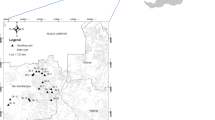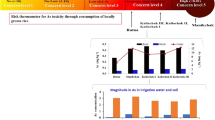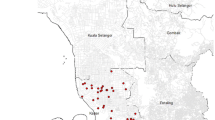Abstract
The abandoned contaminated site remediation has been recognized valuable for their redevelopment bringing social, economic and environmental benefits. The risk assessment is a key step in the process of contaminate site remediation. However, in terms of experience of contaminated site risk assessment, China is in the early stage. A challenge for decision makers responsible for clean-up of contaminated sites has been the understanding the crucial role of risk assessment in the process of contaminated site remediation. In this study, a site-specific human health risk assessment was used to prioritize the high-risk sites contaminated with heavy metals (As, Cd, Hg, Pb, and Zn) in Luoma site, located in Hechi City, China. It is found that, for As, Cd, Pb and Zn, the China’s soil threshold value exceeded in 96%, 78%, 35%, and 43% of analyzed soil samples, respectively. Further studies conclusively showed the soil at Luoma site in its present condition pose non-cancer and cancer risks to potential future receptors. The main contribution of non-cancer and cancer risks was through oral intake. As and Pb were the dominant substances responsible for cumulative risk and sub-areas which require to remediate. The obtained results have confirmed the environment effects and high human health risk at Luoma site. They may also be used to provide scientific basis for contaminated remediation and redevelopment.




Similar content being viewed by others
References
Chen R, De Sherbinin A, Ye C et al (2014) China’s soil pollution: farms on the frontline. Science 344(6185):691
Chiang SYD, Gu Q (2015) Brownfield sites remediation technology overview, trends, and opportunities in China. Remediat J 25(3):85–99
CMEP (Chinese Ministry of Environmental Protection) (1995) Environmental quality standard for soils (GB15618–1995). CMEP, Beijing (In Chinese)
CMEP (Chinese Ministry of Environmental Protection) (2014) Technical guidelines for risk assessment of contaminated sites (HJ 25.3—2014). Beijing. (In Chinese)
Coulon F, Jones K, Li H et al (2016) China’s soil and groundwater management challenges: lessons from the UK’s experience and opportunities for China. Environ Int 91:196–200
CRNCDSR (2015) Chinese residents of nutrition and chronic disease status reports. State Council Information Office of China. http://www.scio.gov.cn/zxbd/tt/jd/Document/1439377/1439377.htm. Accessed 30 Jun 2015
FAO (2000) Assessing soil contamination. A reference manual. FAO Pesticide Disposal Series 8. Food and Agriculture Organization of the United Nations, Rome, Italy
Fernández-Caliani JC (2012) Risk-based assessment of multimetallic soil pollution in the industrialized peri-urban area of Huelva, Spain. Environ Geochem Health 34:123–139. https://doi.org/10.1007/s10653-011-9396-0
Financial Times, Chinese environment: ground operation (2015). http://www.ft.com/cms/s/0/d096f594-4be0-11e5-b558-8a9722977189.html, Accessed 2 Sept 2015
Kabengi N, Chrysochoou M (2015) Soil science in environmental management. In: Sarkar D, Datta R, Mukherjee A, Hannigan R (eds) An integrated approach to environmental management. Wiley, Rome, pp 75–96
Li P, Lin C, Cheng H et al (2015) Contamination and health risks of soil heavy metals around a lead/zinc smelter in southwestern China. Ecotoxicol Environ Saf 113:391–399
Lu Y, Song S, Wang R et al (2015) Impacts of soil and water pollution on food safety and health risks in China. Environ Int 77:5–15
Ordóñez A, Álvarez R, Loredo J (2013) Asturian mercury mining district (Spain) and the environment: a review. Environ Sci Pollut Res 20:7490–7508. https://doi.org/10.1007/s11356-013-1663-4
Qu C, Shi W, Guo J et al (2016) China’s Soil pollution control: choices and challenges. Environ Sci Technol 50:13181–13183
SCC (State Council of the People’s Republic of China) (2016) The National Soil Pollution Prevention and Treatment Action Plan of China. http://www.gov.cn/zhengce/content/2016-05/31/content_5078377.htm (in Chinese)
Stezar IC, Pizzol L, Critto A et al (2013) Comparison of risk-based decision-support systems for brownfield site rehabilitation: DESYRE and SADA applied to a Romanian case study. J Environ Manag 131:383–393
Teng Y, Li J, Wu J et al (2015) Environmental distribution and associated human health risk due to trace elements and organic compounds in soil in Jiangxi province, China. Ecotoxicol Environ Saf 122:406–416
UNESCO (United Nations Educational, Scientific and Cultural Organization) (2012) The Fourth United Nations World Water Development Report: managing water under risk and uncertainty (WWDR4), UNESCO, Marseilles. https://unesdoc.unesco.org/ark:/48223/pf0000215644
US EPA (2000) Superfund Supplemental Guidance to RAGS: Region 4 bulletins, human health risk assessment bulletins (US EPA Region 4, originally published November 1995)
US EPA (2013) Mid-Atlantic risk assessment, User’s guide November 2013. Available at https://www.epa.gov/risk/regional-screening-levels-rsls-generic-tables-november-2015. Accessed Nov 2013
US EPA (2014) Assessing dermal exposure from soil. Region 3 Technical Guidance Manual, risk assessment. Available at https://www.epa.gov/risk/assessing-dermal-exposuresoil. Accessed Dec 2014
US EPA (2015) United States Environmental Protection Agency. Regional screening levels frequent questions. Available at https://www.epa.gov/risk/regional-screening-levelsfrequent-questions-november-2015#FQ13 Accessed Nov 2015
US EPA (1989) Risk assessment guidance for superfund. Human health evaluation manual. Part A. Interim Final, vol 1. Office of Emergency and Remedial Response, Final Publication, Washington (EPA/540/1-89/002)
US EPA (2001) Risk assessment guidance for superfund. Human health evaluation manual. Part D. Standardized planning, reporting, and review of superfund risk assessment, vol 9285. Office of Emergency and Remedial Response, Washington, pp 7–47
US EPA (2002) Supplemental guidance for developing soil screening levels for superfund sites. Office of Solid Waste and Emergency Response, Washington (OSWER 9355.4-24)
US EPA (2003) Recommendations of the technical review workgroup for lead for an approach to assessing risks associated with adult exposure to lead in soil. Final (December 1996). Technical Review Workgroup for Lead, Washington (EPA-540-R-03-001)
US EPA (2009) Update of the Adult Lead Methodology’s default baseline blood lead concentration and geometric standard deviation parameters. Office of Waste and Emergency Response, Washington (OSWER 9200.2-82)
Wcisło E, Bronder J, Bubak A et al (2016) Human health risk assessment in restoring safe and productive use of abandoned contaminated sites. Environ Int 94:436–448
Wu J, Teng Y, Lu S et al (2014) Evaluation of soil contamination indices in a mining area of Jiangxi, China. PLoS One 9(9):e112917
Wu Q, Leung JYS, Geng X et al (2015) Heavy metal contamination of soil and water in the vicinity of an abandoned e-waste recycling site: implications for dissemination of heavy metals. Sci Total Environ 506:217–225
Acknowledgements
This study was financially supported by National Natural Science Foundation of China (No. 41807344).
Author information
Authors and Affiliations
Corresponding author
Ethics declarations
Conflicts of interest
The authors declare no conflict of interest.
Additional information
Publisher's Note
Springer Nature remains neutral with regard to jurisdictional claims in published maps and institutional affiliations.
Rights and permissions
About this article
Cite this article
Li, J., Fan, J., Jiang, J. et al. Human health risk assessment of soil in an abandoned arsenic plant site: implications for contaminated site remediation. Environ Earth Sci 78, 673 (2019). https://doi.org/10.1007/s12665-019-8715-0
Received:
Accepted:
Published:
DOI: https://doi.org/10.1007/s12665-019-8715-0




